Monthly Updates on Recent Books in the History of Christianity
To raise awareness of recent books in the history of Christianity, the editorial staff of Church History: Studies in Christianity and Culture highlights each month a list of 10-15 books in diverse periods and geographical regions that we hope will be of interest to our members. We include here below the thirteenth monthly list, chosen by our staff, with excerpts from the publishers’ blurbs.
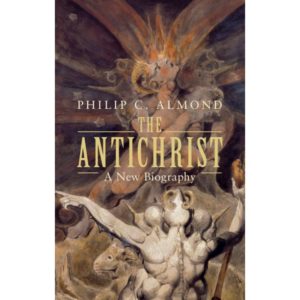
Philip C. Almond, The Antichrist: A New Biography. 2020
The malign figure of the Antichrist endures in modern culture, whether religious or secular; and the spectral shadow he has cast over the ages continues to exert a strong and powerful fascination. Philip C. Almond tells the story of the son of Satan from his early beginnings to the present day, and explores this false Messiah in theology, literature and the history of ideas. Discussing the origins of the malevolent being who at different times was cursed as Belial, Nero or Damien, the author reveals how Christianity in both East and West has imagined this incarnation of absolute evil destined to appear at the end of time. For the better part of the last two thousand years, Almond suggests, the human battle between right and wrong has been envisaged as a mighty cosmic duel between good and its opposite, culminating in an epic final showdown between Christ and his deadly arch-nemesis.
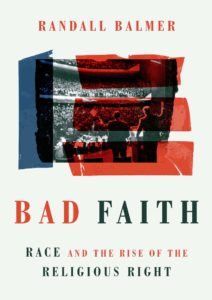
Randall Balmer, Bad Faith: Race and the Rise of the Religious Right. 2021
Largely ambivalent about abortion until the late 1970s, evangelical leaders were first mobilized not by Roe v. Wade but by Green v. Connally, a lesser-known court decision in 1971 that threatened the tax-exempt status of racially discriminatory institutions—of which there were several in the world of Christian education at the time. When the most notorious of these schools, Bob Jones University, had its tax-exempt status revoked in 1976, evangelicalism was galvanized as a political force and brought into the fold of the Republican Party. Only later, when a more palatable issue was needed to cover for what was becoming an increasingly unpopular position following the civil rights era, was the moral crusade against abortion made the central issue of the movement now known as the Religious Right.
In this greatly expanded argument from his 2014 Politico article “The Real Origins of the Religious Right,” Randall Balmer guides the reader along the convoluted historical trajectory that began with American evangelicalism as a progressive force opposed to slavery, then later an isolated apolitical movement in the mid-twentieth century, all the way through the 2016 election in which 81 percent of white evangelicals coalesced around Donald Trump for president. The pivotal point, Balmer shows, was the period in the late 1970s when American evangelicals turned against Jimmy Carter—despite his being one of their own, a professed “born-again” Christian—in favor of the Republican Party, which found it could win their loyalty through the espousal of a single issue. With the implications of this alliance still unfolding, Balmer’s account uncovers the roots of evangelical watchwords like “religious freedom” and “family values” while getting to the truth of how this movement began—explaining, in part, what it has become.
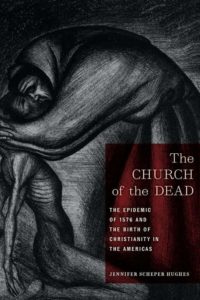
Jennifer Scheper Hughes, The Church of the Dead: The Epidemic of 1576 and the Birth of Christianity in the Americas. 2021
Many scholars have come to think of the European Christian mission to the Americas as an inevitable success. But in its early period it was very much on the brink of failure. In 1576, Indigenous Mexican communities suffered a catastrophic epidemic that took almost two million lives and simultaneously left the colonial church in ruins. In the crisis and its immediate aftermath, Spanish missionaries and surviving pueblos de indios held radically different visions for the future of Christianity in the Americas.
The Church of the Dead offers a counter-history of American Christian origins. It centers the power of Indigenous Mexicans, showing how their Catholic faith remained intact even in the face of the faltering religious fervor of Spanish missionaries. While the Europeans grappled with their failure to stem the tide of death, succumbing to despair, Indigenous survivors worked to reconstruct the church. They reasserted ancestral territories as sovereign, with Indigenous Catholic states rivaling the jurisdiction of the diocese and the power of friars and bishops.
Christianity in the Americas today is thus not the creation of missionaries, but rather of Indigenous Catholic survivors of the colonial mortandad, the founding condition of American Christianity. Weaving together archival study, visual culture, church history, theology, and the history of medicine, Jennifer Scheper Hughes provides us with a fascinating reexamination of North American religious history that is at once groundbreaking and lyrical.
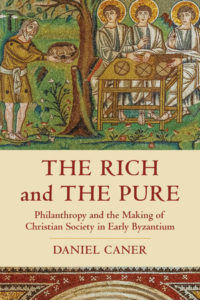
Daniel C. Caner, The Rich and the Pure: Philanthropy and the Making of Christian Society in Early Byzantium. 2021
University of California Press
As the Roman Empire broke down in western Europe, its prosperity moved decisively eastward, to what is now known as the Byzantine Empire. Here was born history’s first truly affluent, multifaceted Christian society. One of the ideals used to unite the diverse millions of people living in this vast realm was the Christianized ideal of philanthrōpia. In this sweeping cultural and social history, Daniel Caner shows how philanthropy required living up to Jesus’s injunction to “Give to all who ask of you,” by offering mercy and/or material aid to every human being, regardless of their origin or status.
Caner shows how Christian philanthropy became articulated through distinct religious ideals of giving that helped define proper social relations among the rich, the poor, and “the pure” (Christian holy people), resulting in new and enduring social expectations. In tracking the evolution of Christian giving over three centuries, he brings to the fore the concerns of the peoples of Early Byzantium, from the countryside to the lower levels of urban society to the imperial elites, as well as the hierarchical relationships that arose among them. The Rich and the Pure offers nothing less than a portrait of the whole of early Byzantine society.

Sébastien Morlet, ed. Jewish-Christian Disputations in Antiquity and the Middle Ages: Fictions and Realities. 2020
Ancient and medieval literature has bequeathed to us dialogues between Jews and Christians. Though there can be no doubt that polemical exchanges existed between individuals in the context of private discussions or formal debates, the exact relation of the dialogical texts and historical reality is sometimes unclear. In the case of ancient Christian dialogues, contradicting analyses have been put forward. Some scholars think they represent reliable documents about the « real » debates. Others contend that such texts are purely literary entities, and that their purpose was self-definition. Certainly no general theory can be adduced to account for all early Christian dialogical texts against the Jews. The present book, however, tries to evaluate both views with a series of contributions on a neglected late antique Greek dialogue, the Dialogue of Timothy and Aquila (6th-7th c. AD). For the sake of comparison, the second part includes papers on a medieval Latin dialogical text, the Dialogus written by Peter Alfonsi (11th-12th c. AD). The last part gathers studies about the less documented other side : Jewish polemical texts against Christianity. The book is introduced by a historiographical survey by William Horbury.
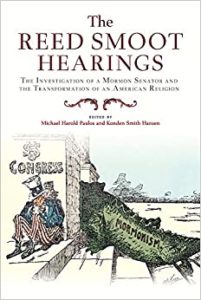
Michael Harold Paulos and Konden Smith Hansen, eds. The Reed Smoot Hearings: The Investigation of a Mormon Senator and the Transformation of an American Religion. 2021
This book examines the hearings that followed Mormon apostle Reed Smoot’s 1903 election to the US Senate and the subsequent protests and petitioning efforts from mainstream Christian ministries disputing Smoot’s right to serve as a senator. Exploring how religious and political institutions adapted and shapeshifted in response to larger societal and ecclesiastical trends, The Reed Smoot Hearings offers a broader exploration of secularism during the Progressive Era and puts the Smoot hearings in context with the ongoing debate about the constitutional definition of marriage.
The work adds new insights into the role religion and the secular played in the shaping of US political institutions and national policies. Chapters also look at the history of anti-polygamy laws, the persistence of post-1890 plural marriage, the continuation of anti-Mormon sentiment, the intimacies and challenges of religious privatization, the dynamic of federal power on religious reform, and the more intimate role individuals played in effecting these institutional and national developments.
The Smoot hearings stand as an important case study that highlights the paradoxical history of religious liberty in America and the principles of exclusion and coercion that history is predicated on. Framed within a liberal Protestant sensibility, these principles of secular progress mapped out the relationship of religion and the nation-state for the new modern century. The Reed Smoot Hearings will be of significant interest to students and scholars of Mormon, western, American, and religious history.
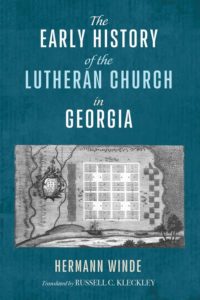
Hermann Winde, The Early History of the Lutheran Church in Georgia. Translated by Russell C. Kleckley. 2021
Beginning with the immigration of the "Georgia Salzburgers," religious exiles from Europe, The Early History of the Lutheran Church in Georgia tells a story of faith and struggle that is deeply embedded in the religious and cultural life of the American colonial South. Previously unpublished and untranslated, Hermann Winde's dissertation laid the foundation for a limited group of scholars and specialists who have continued to develop that story for over four decades. Now, both the detail that emerges through Winde's primary sources and the breadth of the connections he makes across colonial Georgia's geographical and cultural landscape will continue to appeal to scholars and general readers alike as they enter the world of Georgia's first Lutheran communities.

Benjamin J. Wetzel, Theodore Roosevelt: Preaching from the Bully Pulpit. 2021
Theodore Roosevelt is well-known as a rancher, hunter, naturalist, soldier, historian, explorer, and statesman. His visage is etched on Mount Rushmore--alongside George Washington, Thomas Jefferson, and Abraham Lincoln--as a symbol of his vast and consequential legacy. While Roosevelt's life has been written about from many angles, no modern book probes deeply into his engagement with religious beliefs, practices, and controversies despite his lifelong church attendance and commentary on religious issues.
Theodore Roosevelt: Preaching from the Bully Pulpit traces Roosevelt's personal religious odyssey from youthful faith and pious devotion to a sincere but more detached adult faith. Benjamin J. Wetzel presents the president as a champion of the separation of church and state, a defender of religious ecumenism, and a "preacher" who used his "bully pulpit" to preach morality using the language of the King James Bible. Contextualizing Roosevelt in the American religious world of the late nineteenth and early twentieth centuries, Wetzel shows how religious groups interpreted the famous Rough Rider and how he catered to, rebuked, and interacted with various religious constituencies. Based in large part on personal correspondence and unpublished archival materials, this book offers a new interpretation of an extremely significant historical figure.

Dorothea Weltecke, The “Description of the Times” by Mōr Michael the Great (1126-1199): A Study on its Historical and its Historiographical Context. 2021
This is the first in-depth study of the largest medieval Christian chronicle, written by the Syriac Orthodox Patriarch Michael (1126-1199). The codex unicus from 1598, along with remarks made by scribes and by the author himself, is used to reconstruct the original layout of the chronicle. The study compares the chronicle with works that share its form and sources to reveal Michael’s intentions, particularly the (lost) chronicles by Jacob of Edessa (633-708), Patriarch Dionysius of Tel-Mahre (772-834) and the chronicle by Maphrian Bar 'Ebroyo (1226-1286).
Michael studied the history of the world throughout his entire adult life. There is hardly any other medieval Christian chronicler in the West or East who reflected on his method to such an extent. The result was an intricate historical argument as part of the historico-theological disputes of his time. Michael documented a history in which the Suryoye had a place rooted in the secular empires of the Ancient Near East, in their Patriarchal succession and in the heavenly kingdom of the Anointed One.

Håkon Fiane Teigen, The Manichaean Church at Kellis: Social Networks and Religious Identity in Late Antique Egypt. 2021
The Manichaean Church in Kellis presents an in-depth study of social organisation within the religious movement known as Manichaeism in Roman Egypt. In particular, it employs papyri from Kellis (Ismant el-Kharab), a village in the Dakhleh Oasis, to explore the socio-religious world of lay Manichaeans in the fourth century CE.
Manichaeism has often been perceived as an elitist, esoteric religion. Challenging this view, Teigen draws on social network theory and cultural sociology, and engages with the study of lived ancient religion, in order to apprehend how laypeople in Kellis appropriated Manichaean identity and practice in their everyday lives. This perspective, he argues, not only provides a better understanding of Manichaeism: it also has wider implications for how we understand late antique ‘religion’ as a social phenomenon.
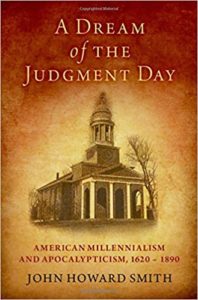
John Howard Smith, A Dream of the Judgment Day: American Millennialism and Apocalypticism, 1620-1890. 2021
The United States has long thought of itself as exceptional--a nation destined to lead the world into a bright and glorious future. These ideas go back to the Puritan belief that Massachusetts would be a "city on a hill," and in time that image came to define the United States and the American mentality. But what is at the root of these convictions? John Howard Smith's A Dream of the Judgment Day explores the origins of beliefs about the biblical end of the world as Americans have come to understand them, and how these beliefs led to a conception of the United States as an exceptional nation with a unique destiny to fulfill. However, these beliefs implicitly and explicitly excluded African Americans and American Indians because they didn't fit white Anglo-Saxon ideals. While these groups were influenced by these Christian ideas, their exclusion meant they had to craft their own versions of millenarian beliefs. Women and other marginalized groups also played a far larger role than usually acknowledged in this phenomenon, greatly influencing the developing notion of the United States as the "redeemer nation."
Smith's comprehensive history of eschatological thought in early America encompasses traditional and non-traditional Christian beliefs in the end of the world. It reveals how millennialism and apocalypticism played a role in destructive and racist beliefs like "Manifest Destiny," while at the same time influencing the foundational idea of the United States as an "elect nation." Featuring a broadly diverse cast of historical figures, A Dream of the Judgment Day synthesizes more than forty years of scholarship into a compelling and challenging portrait of early America.

Nicholas T. Pruitt, Open Hearts, Closed Doors: Immigration Reform and the Waning of Mainline Protestantism. 2021
Open Hearts, Closed Doors uncovers the largely overlooked role that liberal Protestants played in fostering cultural diversity in America and pushing for new immigration laws during the forty years following the passage of the restrictive Immigration Act of 1924. These efforts resulted in the complete reshaping of the US cultural and religious landscape.
During this period, mainline Protestants contributed to the national debate over immigration policy and joined the charge for immigration reform, advocating for a more diverse pool of newcomers. They were successful in their efforts, and in 1965 the quota system based on race and national origin was abolished. But their activism had unintended consequences, because the liberal immigration policies they supported helped to end over three centuries of white Protestant dominance in American society.
Yet, Pruitt argues, in losing their cultural supremacy, mainline Protestants were able to reassess their mission. They rolled back more strident forms of xenophobia, substantively altering the face of mainline Protestantism and laying foundations for their responses to today’s immigration debates. More than just a historical portrait, this volume is a timely reminder of the power of religious influence in political matters.
Finally, for staying up-to-date on the latest titles in all fields, we recommend regularly perusing New Books Network and its "New Books in Christian Studies” page. These pages are updated regularly.
